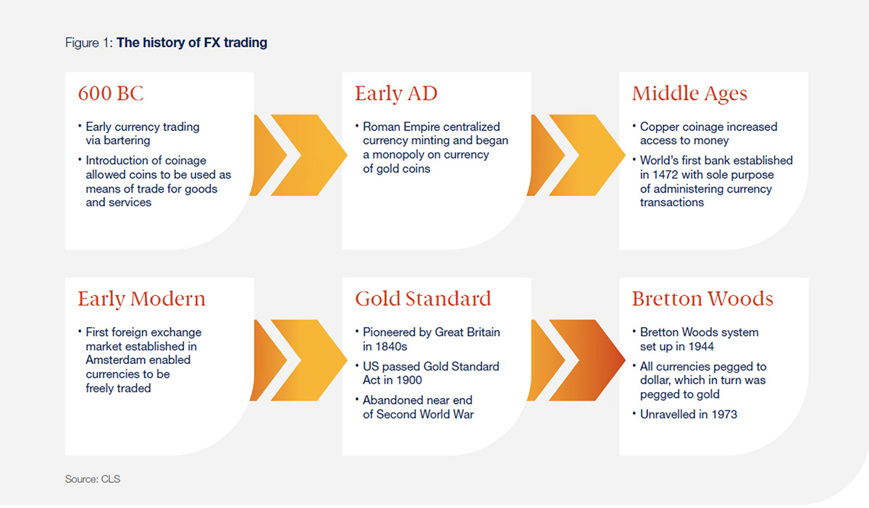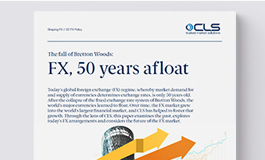FX policy 02 | The fall of Bretton Woods: FX, 50 years afloat | ShapingFX series
Today’s global foreign exchange (FX) regime, whereby market demand for and supply of currencies determines exchange rates, is only 50 years old. After the collapse of the fixed exchange rate system of Bretton Woods, the world’s major currencies learned to float. Over time, the FX market grew into the world’s largest financial market, and CLS has helped to foster that growth. Through the lens of CLS, this paper examines the past, explores today’s FX arrangements and considers the future of the FX market.
The past
The global FX market – the largest financial market in the world – is steeped in rich history (figure 1).1 As the American astronomer Carl Sagan famously put it, “you have to know the past to understand the present.” So let us take a look at how developments over time have led to the FX market we know today and CLS’s vital role within it.
How it all began
The use of currency evolved over centuries. Coins were first introduced around 600 BC.2 Fast forwarding to the 15th century, Banca Monte dei Paschi di Siena, the world’s first bank, was created with the sole purpose of administering currency transactions. This institution was lending money before Columbus discovered America.
The first FX marketplace – where the growing number of banks could freely trade currencies – was established in Amsterdam in the 17th century, helping to stabilize currency exchange rates3 and paving the way for the model that exists today. The shiny centerpiece at the heart of these developments – and all currency trading – was gold.
“The “gold standard” became the established regime for fixing exchange rates around the world...”
The old but gold standard
The “gold standard” became the established regime for fixing exchange rates around the world, wherein most currencies were valued according to a specific weight of gold.4 Though the gold standard allowed world trading to accelerate rapidly over the second half of the 19th century,5 it led to considerable volatility in the FX market. Moreover, the gold standard was inflexible and did not allow countries the discretion to adjust monetary policy in response to periods of extreme economic hardship, such as the Great Depression and the two World Wars.6

1Chaboud, A. et al. (2023) The Foreign Exchange Market.2Ancient Egyptian and Greek civilizations traded goods and services for silver and gold coins. The Roman Empire
centralized currency minting and began a monopoly on a currency of gold coins. Copper became a popular medium
for minted coins in the Middle Ages, granting more people access to lower value coins.3Huzefa, H. (2008) The History of the Forex Market, DailyForex.4The gold standard was pioneered by Great Britain in the 19th century. Large scale production of gold in the US began
with the California Gold Rush of 1848. In 1861, the US printed its first paper money, and the Gold Standard Act (1900)
made gold the only metal to be exchangeable for paper currency. By that point most currencies around the world were
pegged to gold, or ‘the gold standard’.5Federico, G., Tena-Junguito, A. (2019) World Trade, 1800-1938: A New Synthesis, Revista De Historia Economica
– Journal of Iberian and Latin American Economic History, 37(1).6Cassel, G (2017) The Downfall of the Gold Standard.
